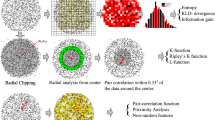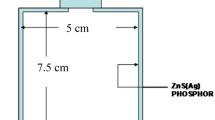Abstract
A preliminary procedure for alpha-energy analysis of radon and its progeny using nuclear track methodology (NTM) is described in this paper. The method is based on the relationship between alpha-particle energies deposited in polycarbonate material (CR-39) and the track size developed after a well-established chemical etching process. Track geometry, defined by parameters such as major or minor diameters, track area and overall track length, is shown to correlate with alpha-particle energy over the range 6.00 MeV (218Po) to 7.69 MeV (214Po). Track features are measured and the data analyzed automatically using a digital imaging system and commercial PC software. Examination of particle track diameters in CR-39 exposed to environmental radon reveals a multi-modal distribution. Locations of the maxima in this distribution are highly correlated with alpha-particle energies of radon daughters, and the distributions are sufficiently resolved to identify the radioisotopes. This method can be useful for estimating the radiation dose from indoor exposure to radon and its progeny.
Similar content being viewed by others
References
C. F. Wong, L. Tommasino, Nucl. Tracks, 6 (1982) 17.
G. Espinosa, L. Tommasino, R. Griffith, I. Gamboa, I. Jacobson, J. I. Golzarri, Nucl. Tracks Radiat. Meas., 8 (1984) 433.
G. W. Phillips, J. Span, J. S. Bogard, T. Vo Dinh, D. Emfietzoglou, R. Devine, M. Moscovitch, Proc. of the 14th Intern. Conf. on Solid State Dosimetry, New Haven CT, June 27–July 2, 2004, Radiat. Prot. Dosim., 119 (2006) 491.
A. M. Abdel Moneim, A. Addel Naby, F. A. El Ekkad, Nucl. Tracks Radiat. Meas., 21 (1993) 235.
G. Espinosa, R. B. Gammage, K. E. Meyer, C. S. Dudney, Radiat. Prot. Dosim., 66 (1996) 363.
A. P. Fews, D. L. Henshaw, Nucl. Instr. Meth., 197 (1982) 517.
M. Izerrouken, J. Skvarc, R. Illic, Nucl. Tracks Radiat. Meas., 31 (1999) 141.
G. Somogyi, I. Hunyadi, A. F. Hafez, G. Espinosa, Nucl. Tracks Radiat. Meas., 8 (1984) 163.
G. Espinosa, Trazas Nucleares en Sólidos, IFUNAM-PUMA-UNAM, Mexico, 1984.
G. Espinosa, R. B. Gammage, Appl. Radiation Isotopes, 44 (1993) 719.
Author information
Authors and Affiliations
Corresponding author
Rights and permissions
About this article
Cite this article
Espinosa, G., Golzarri, J.I. & Bogard, J.S. Radon and progeny alpha-particle energy analysis using nuclear track methodology. J Radioanal Nucl Chem 277, 131–135 (2008). https://doi.org/10.1007/s10967-008-0720-9
Received:
Published:
Issue Date:
DOI: https://doi.org/10.1007/s10967-008-0720-9




